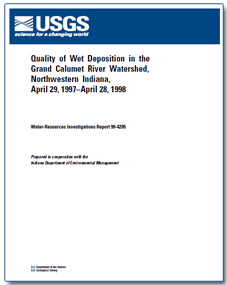Water Resources Investigations 99-4205
By Timothy C. Willoughby

IntroductionThe Grand Calumet River, in northwestern Indiana, drains a heavily industrialized area along the southern shore of Lake Michigan. Steel production and petroleum refining are two of the area’s predominant industries. High-temperature processes, such as fossil-fuel combustion and steel production, release contaminants to the atmosphere that may result in wet deposition being a major contributor to major-ion and trace-metal loadings in north-western Indiana and Lake Michigan. A wet-deposition collection site was established at the Gary (Indiana) Regional Airport to monitor the quantity and chemical quality of wet deposition. During a first phase of sampling, 48 wet-deposition samples were collected weekly between June 30, 1992, and August 31, 1993. During a second phase of sampling, 40 wet-deposition samples were collected between October 17, 1995, and November 12, 1996. Forty-two wet-deposition samples were collected during a third phase of sampling, which began April 29, 1997, and was completed April 28, 1998. Wet-deposition samples were analyzed for pH, specific conductance, and selected major ions and trace metals. This report describes the quantity and quality of wet-deposition samples collected during the third sampling phase and compares these findings to the results of the first and second sampling phases. All of the samples collected during the third phase of sampling were of sufficient be performed. Constituent concentrations from the third sampling phase were not significantly different (at the 5-percent significance level) from those for the second sampling phase. Significant increases, however, were observed in the concentrations of potassium, iron, lead, and zinc when compared to the concentrations observed in the first sampling phase. Weekly loadings were estimated for each constituent measured during the third sampling phase. If constituent concentrations were reported less than the method reporting limit, a range for the weekly loading was computed. The estimated annual loadings of chloride, silica, bromide, copper, and zinc during the third sampling phase were greater than those estimated for the first two sampling phases. The only estimated annual loading in the third sampling phase that was less than the estimated annual loadings observed during the first two sampling phases was sulfate. The estimated annual loadings of calcium, magnesium, nitrate, potassium, barium, lead, iron, and manganese observed during the third sampling phase were greater than the loadings observed during the first sampling phase but less than those observed during the second sampling phase. No significant differences were observed between the quantity of wet deposition collected during the three sampling phases. |
For additional information contact: Part or all of this report is presented in Portable Document Format (PDF); the latest version of Adobe Reader or similar software is required to view it. Download the latest version of Adobe Reader, free of charge. |
Suggested citation:
Willoughby, T.C., 1999, Quality of wet deposition in the Grand Calumet River watershed, Northwestern Indiana, April 29, 1997–April 28, 1998: U.S. Geological Survey Water Resources Investigations Report 99-4205.